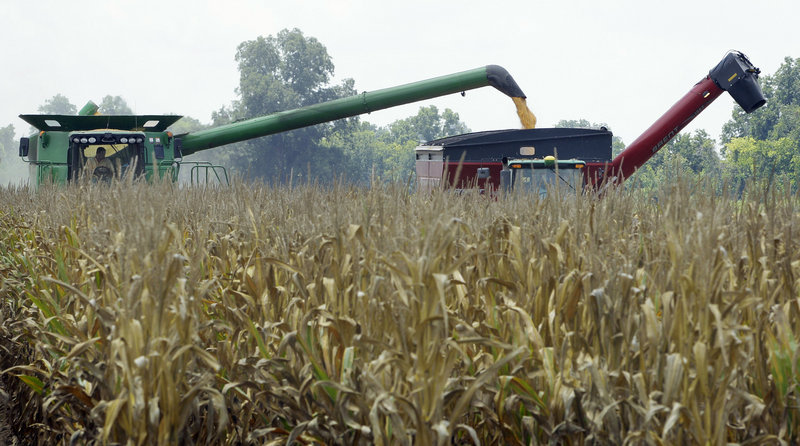ST. LOUIS – The U.S. Agriculture Department on Friday cut its estimate of the nation’s corn crop for the second consecutive month, adding to concern about food price increases as the nation’s worst drought in decades deepens.
The USDA predicted the nation’s biggest harvest ever in the spring, when farmers planted 96.4 million acres of corn — the most since 1937. It cut its estimate a month ago to the third-largest harvest, and on Friday, to the eighth-largest and the smallest since 2006.
If that estimate holds, the U.S. will produce 10.8 billion bushels of corn this year. The federal government says that is enough to meet the world’s needs and ensure there are no shortages. But experts say food prices will almost certainly climb as corn is a widely used ingredient found in everything from cosmetics to cereal, colas and candy bars.
The drought stretching across the U.S. from Ohio west to California is deepest in the middle of the country, and major farm states like Iowa and Illinois are seeing conditions get worse each week. Farmers credit advances in seed technology that have produced hardier, more drought-tolerant corn for any harvest at all.
“I have to be honest with you, I’m totally stunned we have corn with green stalks and leaves after going through weeks of 105-degree temperature,” said Garry Niemeyer, the National Corn Growers Associated president who has 1,200 acres of corn and 800 acres of soybeans near Auburn, Ill. “Our corn yield normally would be about 190 bushels per acre. This year, if I get 110, I’d be thrilled to death.”
The USDA’s latest estimate predicts corn farmers will average 123.4 bushels per acre, down 24 bushels from last year in what would be the lowest average yield in 17 years. But that would still be an improvement from a decade ago, when the average was about 129 bushels in a year without drought.
Agriculture Secretary Tom Vilsack trumpeted the resilience of U.S. farmers and ranchers on Friday, saying he didn’t expect immediate increases in food prices and was optimistic the U.S. would continue meeting global demand for grain. The U.S. is the world’s top exporter of corn, soybeans and wheat.
“Americans shouldn’t see immediate increases in food prices due to the drought,” Vilsack said during a trip to drought-stricken Nebraska. “What is important going forward is that we continue to do all we can to help the farmers, ranchers, small businesses and communities being impacted by this drought.”
But experts have already been predicting increases in food prices. Rick Whitacre, a professor of agricultural economics at Illinois State University, said he believes the greatest impact will be in meat and poultry prices, given that many ranchers have sold off livestock as pastures dry up and feed costs rise.
The selloff will result in lower prices through December with a glut of meat on the market – but higher costs beginning next year. Whitacre predicted an eventual 4 percent to 6 percent increase in the cost of pork and beef.
“You’re going to see the ripple of this go out for quite a distance,” he said.
The effect on packaged goods and other products is harder to predict because the price of corn may be only a small part of the total cost. For example, even with today’s high corn prices, a 12-ounce box of cornflakes would have only about 8 cents worth of corn, said Paul Bertels, vice president of production and utilization at the National Corn Growers Association. That’s a very small portion of the $4 or so consumers might pay for that box of cereal.
Dennis Conley, an agricultural economist in University of Nebraska’s Institute of Agriculture and Natural Resources, said he expected to see nominally higher prices in U.S. supermarkets, although when “is the million-dollar question.” He thought it might be a month or two before products using corn cost more.
Corn prices have been going up with steady reports of worsening drought and crop damage, jumping from just under $6 a bushel in late June to over $8 a bushel in early August.
Send questions/comments to the editors.




Success. Please wait for the page to reload. If the page does not reload within 5 seconds, please refresh the page.
Enter your email and password to access comments.
Hi, to comment on stories you must . This profile is in addition to your subscription and website login.
Already have a commenting profile? .
Invalid username/password.
Please check your email to confirm and complete your registration.
Only subscribers are eligible to post comments. Please subscribe or login first for digital access. Here’s why.
Use the form below to reset your password. When you've submitted your account email, we will send an email with a reset code.